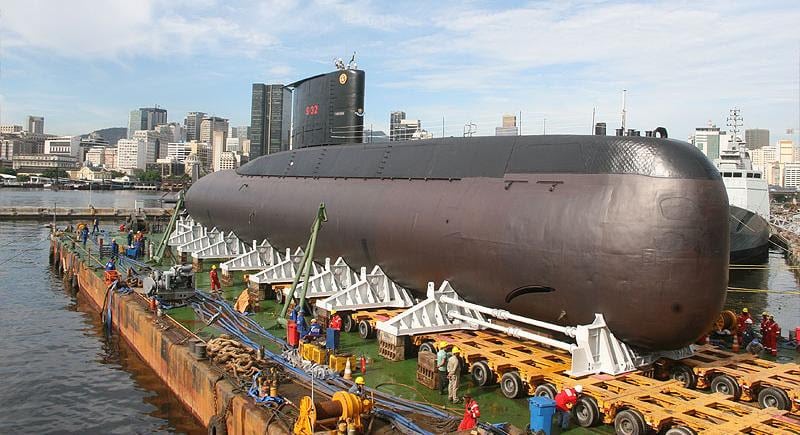Brazil wishes to sell two to four Tupi class submarines (Type 209/1400), with the fifth remaining in service until the 2030s in addition to the four S-BR (Scorpène – Brasil). Argentina is in the running to purchase two submarines. But Peru, also mentioned since September, also seems to be able to benefit from a political agreement based on the exchange of a pair of submarines for a Peruvian Makassar-class Landing Barge Transport (TCD).
Le Plan of Articulation and Equipment of Marine do Brasil (PAEMB) of 2009 is the naval version of theDefesa National Strategy (December 18, 2008). The PAEMB covers the period 2009 – 2030 with forecasts for the efforts to be produced in the following period (2030 – 2047). The execution of naval programs is entrusted to the Diretoria de Gestão de Programas Estratégicos da Marinha (DgePEM). The two main PAEMB programs are the Program for obtaining benefits from SUPerfície (PROSUPER) and PROGRAM OF DESENVOLIMENTO SUBbmarinos (PROSUB).
PROSUPER had the ambition to locally build four Navios de Propósitos Múltiplos (NPM) or Multiple-Use Ships in French: that is to say large multi-purpose amphibious units. To this end, Brazil showed interest in several buildings of this type including the family of Projection and Command Buildings (BPC 140 to BPC 240).

Brazil came forward to apply for the acquisition of the second TCD of the Foudre class, namely the Sirocco (1996 – 2015) from 2014. Chile, purchaser of Lightning (1990 – 2011) had an option on the Sirocco but could not exercise it due to lack of the necessary budget. Portugal, also interested, could not either. It was acquired by the Brazilian Navy under the name NAM. Bahia (2015). This TCD (or Landing Platform Dock (LPD) in English) can accommodate in good conditions 450 troops (900 for a short period), around 200 armored vehicles and vehicles (including 22 battle tanks), 4 H225M helicopters and up to 8 barges. The purchase of the ex-HMS Ocean (1998 – 2018) in July 2018 in the United Kingdom constitutes the first of four Navios de Propósitos Múltiplos (NPM) targeted by the PAEMB. Renamed PHM Atlantic, this fully loaded 21-ton helicopter carrier without a raft can accommodate 500 troops, 830 armored vehicles and up to 40 helicopters.
These two recently acquired buildings complete the NDCC (Navio de Démbark de Carros de Combate) Mattoso Maia (tank landing craft, 8700 tons) and theAlmirante Sabóia (amphibious support ship, 7700 tonnes) whose first admissions to active service date back, respectively, to 1970 in the US Navy (Newport class) and 1967 in the Royal Navy (Round Table class). Aged 49 and 52, they remain to be replaced. The NDCC lmirante Sabóia must be disarmed in January 2020. It is in this perspective that the negotiations between Brazil and Peru are taking place. The Brazilian vice-president, in the absence of Head of State Jair Bolsonaro because he was traveling abroad until October 31, went to Lima on October 23 to negotiate military agreements.

This transfer of Brazilian S-32 submarines Timbira (1996) and S-33 Tapajo (1999) from the Tupi class (Type 209/1400) would make it possible to support theadmission to the service of the four S-BR (Scorpène BRasil) and maintain the S-34 Tikuna (2007 – 2037?), a Type 209/1400 Mod, until the 2030s. This transfer project rules out, de facto, the modernization projects of two of the four submarines and therefore any increase in the format of the submarine which will remain around an average of five to six submarines. Peru declares itself interested in this transfer to replace its two oldest Type 209/1100 submarines, that is to say the Islay (1975) et Arica (1975). Its four other Type 209/1200 submarines are barely younger: entering service between 1980 and 1983.
In exchange for the pair of Brazilian submarines, Peru offers the BAP Pisco (2018), that is to say a TCD of the Makassar type built under license by SIMA (Servicios Industriales de la Marina SA) between 2013 and 2018, the year of its admission to active service. Brazil's interest would be twofold because this amphibious unit (10 tonnes, 900 troops, 450 armored vehicles and 24 trucks, 18 barges and a hangar for 2 helicopter) would ideally allow the replacement of the NDCC lmirante Sabóia which must be disarmed in January 2020. The Brazilian amphibious group, rejuvenated and with increased operational value, would be able to embark around 2100 troops, plus 312 armored vehicles and vehicles including 66 battle tanks and 22 helicopters.
But it would rather be the replacement of the NE school building Brazil (subclass of the Niterói-class corvettes) of 3355 tons which entered service in 1986. With this in mind, the Chilean Makassar-type TCD would serve, like the former helicopter-carrying cruiser Jeanne D'Arc, for its main mission as a school building and occasionally would reinforce the Brazilian amphibious group. In order to achieve the objectives of the PAEMB (4 major amphibious units and 1 training vessel), the Brazilian Navy could then argue that it remains to acquire two large amphibious units in order to provide for the replacement of the NDCC Mattoso Maia but also to deliver the Makassar type TCD paid as a training building. The options remain open depending on the opportunities that arise on the second-hand market. Peru put the twin brother of the BAP on hold on December 14, 2017 Pisco : the BAP Paita. Will it also be offered
